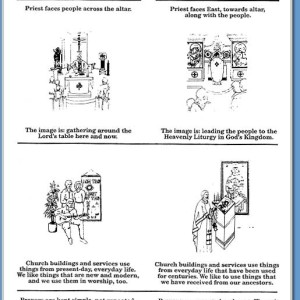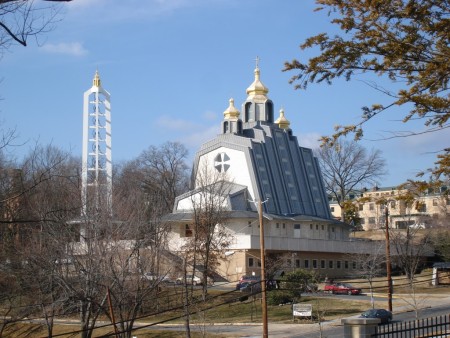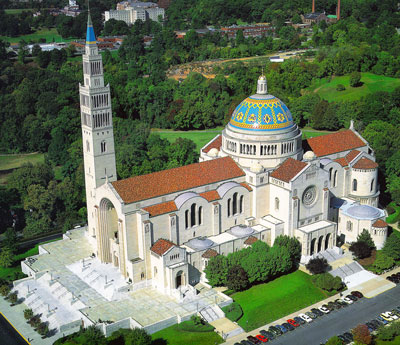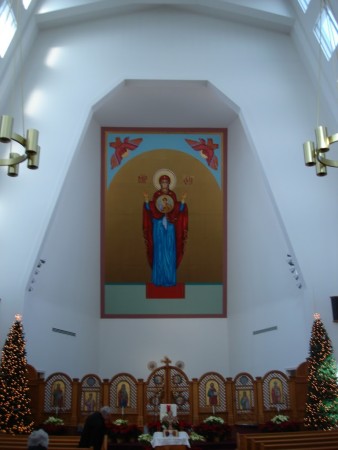Holy Saturday sometimes gets lost in the mix in Roman-Rite Catholicism. Holy Thursday is huge (the Institution of the Eucharist and the priesthood), Good Friday is huge (Christ removing the curse of sin on the Cross), and Easter Sunday is huge (the Resurrection). And Easter Vigil on Saturday night is the biggest Mass of the entire year, in every possible sense: it’s the longest, most epically beautiful Mass of the entire year. Usually there are two Readings at daily Mass, and three on Sundays (one Old Testament, one from New Testament epistles, and one from the Gospels). On Easter Vigil, there are nine, telling the story of the Fall of Man to the Christological prophesies to the account of the Resurrection. Over about two and half hours, we hear the story of humanity from start to finish, celebrate the Resurrection, invite new Catholics into the Church through baptism and confirmation, and so on.
In comparison, Holy Saturday is sometimes just a “breather” until Easter Vigil at sunset. After all, the Gospels are nearly silent as to Holy Saturday — the Apostles are observing the Jewish Sabbath, while their faith in Christ is put to the test. Not so in Eastern Catholicism. This morning at 10:30 AM, two of my friends and I went to the Ukrainian Catholic National Shrine of the Holy Family (UCNS) for Jerusalem Matins, which I’d heard was beautiful:
The Jerusalem Matins is arguably the most aesthetically beautiful service of the entire Christian year. During the Matins, we accompany the Faithful Myrrh-bearing Women and their Companions, who, keeping Vigil at the Graveside, mourn the Crucified Christ. The hymns are hauntingly lyrical and reflect a profound spirituality, expressing the anguish of loss and the yearning for restoration and justice.
The Jerusalem Matins are beautiful: they sing about Joseph of Arimathea and Nicodemus, who laid Jesus in the Tomb (John 19:38-42); about Judas, who despaired and hung himself (Matthew 27:3-5; Acts 1:18); about the Virgin Mary’s intense longing for Her dead Son (Luke 2:34-35); and about Adam and Eve receiving redemption from Christ in Hades (1 Peter 3:18-22).
One of the first things we noted upon coming into the church was that off to one side, they had these charts comparing Byzantine Catholicism and Roman Catholicism. Here’s one of them:
Two things on these. First, they’re obviously a well-meaning attempt to show that Roman and Byzantine are complementary forms of worshiping God, and that there’s no need for jealousy or rivalry. As the chart says, “the faith is the same, but we express it differently.” Second, these are unintentionally humiliating from a Roman perspective. The Byzantine Liturgy is beautiful and traditional with traditional iconography, while the Roman Rite Mass is two men and a woman playing guitar next to an “I am the Light of the World” banner, and praises modernity and simplicity. Another chart explains that the Byzantines like churches that are traditional, while Romans like modern architecture. Ironically, this is the Byzantine church that chart was in:
And here’s the Roman Rite Basilica down the block:
So I think it’s fair to say that the chart was speaking in generalities. In fairness, the UCNS is pretty traditional from a Ukranian-Catholic perspective. It just seems funky and modern because the architecture is so strange to me. The UCNS’s interior was simple but beautiful:
In the middle of the church, where the cross is in that picture, was a miniature tomb which apparently exists just for Holy Saturday. Three chairs were in front of the tomb, for the three celebrants. When we arrived at about 10:20, we thought we might be in the wrong place, because we were the only two cars in the parking lot. As it turns out, we were the first ones there other than the celebrants. One was a Byzantine priest in a Roman collar, Fr. Robert Hitchens (seen on the left here); and two other men were with him, similarly clad, sans collar — I’m not sure if they were priests, deacons, or something else.
Afterwards, Fr. Hitchens came over and welcomed us to the church, and apologized for the light showing, explaining that many in the congregation were older, and had been worried about the forecast rain, and that others struggled with these Matins, because they’re only sung once a year, and are hard to sing.
This is, more or less, what it was like, only with fewer singers:
What was striking was how beautiful the words were, giving words to the Mystery of Holy Saturday. Let me share a few examples, if I may. It began with a series of stichera, alternating with lines from the Psalms. For example, in the Third Station, we prayed:
Let Your face shine on Your servant and teach me Your decrees.
We hasten with the Myrrh-bearers and draw near to Your tomb to anoint Your body, O living God.
Tears stream from my eyes because your law is disobeyed.O thrice-blessed Joseph, you offer your respects to the most pure body of Christ the Lord and Master of life.
Lord, You are just indeed; Your decrees are right.Those whom He fed in the desert, giving them their fill of manna, have conspired against their Benefactor.
You have imposed Your will with justice and with absolute truth.Those whom He fed in the desert, giving them their fill of manna, offer Him vinegar and gall.
Come, let us contemplate our Life placed in the tomb , that those who lie in the tombs may live. Come, let us contemplate today the Lion of Judah; with the prophet, let us cry out to Him: You rest and sleep, and who can awaken You, O our King? Arise, in Your power, O Lord, Who willingly gave Yourself for us, glory to You.
Praise Him with resounding cymbals, praise Him with clashing of cymbals. Let everything that lives and breathes give praise to the Lord.
Joseph asked for Your most pure body, and he placed it in his new tomb. For it is fitting that You come forth from the tomb as from a bridal chamber. You have broken the kingdom of death, O Christ, and opened the gates of paradise to mortals; O Lord, glory to You.
Glory be to the Father, and to the Son, and to the Holy Spirit.Today the mystical word of the prophet Moses is fulfilled: And God blessed the seventh day. For behold, this is the blessed day of the sabbath, behold, this is the day of rest, on which the only Son of God rested from all His work. In His bodily death which He endured for our salvation, He returns to the glory from which He came; and by His resurrection, He grants eternal life in His goodness and love for mankind.
The theology here is incredibly rich. Everything from the way it shows that Exodus 20:11 was prophetic of Christ’s Sabbath in the Tomb, to the depiction of Christ as the Bridegroom whose bridal chamber was the Tomb (see, e.g., Luke 5:33-35, Revelation 22:16-17), shows a deep understanding of the meanings within Sacred Scripture, and presented in an astonishingly beautiful way.
I’m already planning to go back at some point, preferably for a Divine Liturgy where more people will be there. It was beautiful and spiritually uplifting.




